|
Plans
are being made now for the Australian Army of the future. It is more
than interesting at this point to cast a glance back. Take, for
instance,
the Victorian units. What quaint pictures are bought to view as we turn
over the pages of our short history.
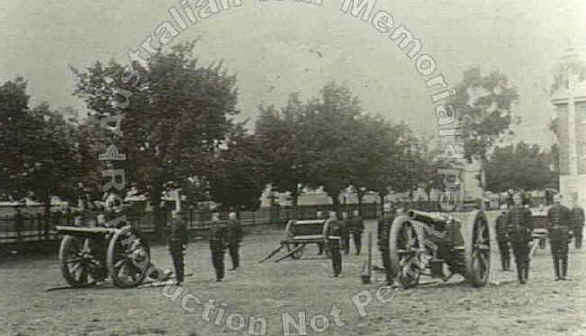 |
| Tasmania,
1902.
Launceston Volunteer
Artillery, siege gun section: 40 pounder Armstrong B. L. Siege
guns at Paterson Barracks, Launceston. Two of those guns were
issued to the battery in 1884 and were in use until the
disbandment of the siege section in 1900
(donor: Major General J. S.
Whitelaw AO CBE)
|
Nearly
ninety years ago men with luxuriant, dashing whiskers were drilling with
Snider and Martini-Henry rifles and smoothbore muzzle-loading guns in
preparation for an attack on Australia by bearded Russians! In those
days the little brown man from Japan was not thought of other than as a
cheerful and acrobatic personality.
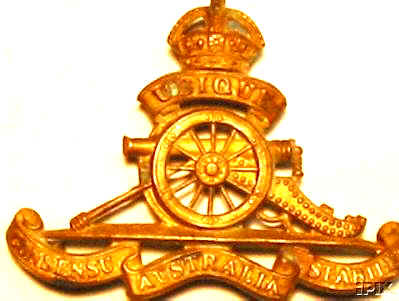 |
One
reads and hears a lot about "crack" regiments of the past,
notably those connected with the artillery arm, but how many today know
anything about "Sargood's Kids", "Stubbs' Bulldogs",
the "Ham and Beef' battery and the "Rupertswood" battery
of Horse Artillery, all well known regiments of early Victoria.
These
were the men of other days, the great-grandfathers of the A.I.F.
|
|
Tasmanian
Artillery Badge, pre Federation |
Victoria
early began a military system, which, when the importance of the then
colony increased, became sufficient to meet any aggression. Fate was
kind, for although from time to time there had
been many premonitions of international trouble in which Victoria
might have been involved, the nearest clash of arms was the Maori War of
1860.
In
1854 three field artillery batteries were raised under a Volunteer Act
the Metropolitan, East Melbourne
and St. Kilda batteries, members of which were dressed in a blue uniform
with scarlet facings. By 1874 the
St. Kilda battery was commanded by Major
(later Sir) Frederick Sargood, who in the course of time became a
lieutenant colonel, and in the Victorian Legislature became Minister
for Defence. It was he who sponsored the changeover from the volunteer
system to the militia system in 1883.
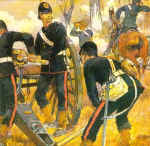 |
The
St. Kilda battery was reputed to be the "crack" battery of
the time and also the best dressed.
They had the large brass letters
"SK" (for St. Kilda) on their shoulder straps, but to the
"boys" of those days the interpretation quickly became
"Sargood's Kids" alluding, of course, to the name of their
commanding officer.
And proud they were of the nickname!
|
In
1870, the war between France and Germany, and the possible contingency
that England might be drawn into it, caused considerable anxiety in the
public mind and steps were taken to establish a corps of permanent
artillery in Victoria. This corps consisted of seventy men including all
the drill instructors who, for some strange reason, were classed as
artillerymen. For many years the corps under the command of Captain
Stubbs, a retired officer of the British Army, held pride of place among
the land forces of the colony. They rejoiced in the sobriquet of
"Stubbs' Bulldogs", which, far from insinuating any bullying
aptly combined their tenacity and the name of their esteemed leader. But
among the eyes focused on the corps were those of the Chief Commissioner
of Police.
After each man had given full proof of his efficiency as a
soldier his services were claimed in order to complete the establishment
of the Victorian Police Force.
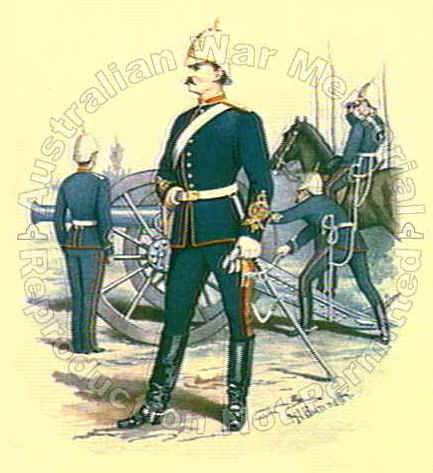 |
Victorian
Artillery |
"Stubbs'
Bulldogs" were condemned by the Victorian Treasury as a serious
waste of public money because they appeared to exist simply for training
policemen at great expense. In a severe retrenchment, much to the regret
of the military authorities, the Government ordered their disbandment in
December 1880. One officer and
twelve men were retained for military works.
 |
Perhaps
the most notable regiment of the gay days of the eighties was the
Victorian Horse Artillery known to everybody in those days as the
"Rupertswood" battery, an appellation they carried to
perpetuate the name of the house of their sponsor, Sir W. J. Clarke, at
Sunbury.
Their original formation goes back to 1885 when approval was
given for the formation of a section of a Nordenfeldt Battery in
connection with the Victorian Cavalry.
In 1889 this battery, was converted into the Victorian Horse Artillery,
under the command of Major (later Brigadier-General) F. G. Hughes
with headquarters at the Sunbury house of Sir W. J. Clarke, who,
at his
own expense, maintained the unit.
About
the same time Mr Chirnside undertook the maintenance at Werribee of a
half-battery on similar lines, armed with 12 pounder field guns.
These batteries were composed of the cream of Victorian amateur
athletes, and were very soldier-like in their bearing and neat in
their dress which was similar to that worn by the famous batteries of
the Royal Horse Artillery, the only difference being that they had a
white helmet instead of the familiar Busby.
|
The
"Rupertswood" battery was indeed a fine body of men. Their
drivers could handle a team of horses in many difficult manoeuvres not
seen today. It was really a sight to see them disentangle one of the
horses which overstepped the traces of a gun team the horse artillery
driver of those days was indeed a man to himself and the
"Rupertswood" battery contained many of them.
 |
Of course the other
Colonies had Artillery Batteries as well
<<
Lt Col NSW Field Artillery 1886
Qld Permanent Artillery 1890 >> |

|
How
many people know that there was once a bullock battery in Victoria? On
20 July 1890 the Government of Victoria approved of the formation of a
battery of artillery at Hastings, and of its being designated "The
Hastings 40 Pounder Battery, Victorian Rangers". This battery,
sometimes called in error the "bullock battery", was formed
through the energies of Colonel Teddy ("Battleaxe") Otter. The
personnel of the battery must have been recruited from men with the
vocabulary necessary to handle the unemotional animals yoked to the
guns. The unit was, in fact, a position battery for the protection of
Western Port, and took the place of earthworks for the defence of that
locality. It had an establishment of fifty-four all ranks.
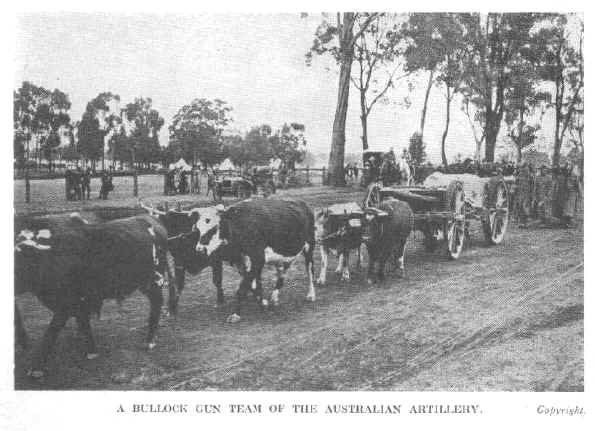
Victorians
of their day always referred jokingly to the battery as the "cow
battery". It was commanded by Major Ham and from this fact it
earned the popular sobriquet of the "Ham and Beef" battery.
The members of the battery wore uniform similar to the garrison
artillery arm, except that the material was of
khaki cloth instead of
blue; khaki helmets with brass ball and mountings were worn and also the
"pillbox" forage cap.
It would be doing the Hastings
Battery
an in justice if the name of their sergeant major (Jack Creaney) were
not mentioned. He knew the men, he knew the guns and one might even say
the bullocks. He used to say that there were no words of command laid
down for the bovines, that was left to the driver.
Taking
into consideration the scanty population of the district at the time
this battery was in existence, it is interesting to record that it's
strength always exceeded its establishment. Men of the old "Ham and
Beef" Battery were a fine lot and were skilful and speedy in their
work.
R.
K. PEACOCK
(V.P.A.
and R.A.G.A.) from AS YOU WERE! 1946
by the AWM
|